Literature Review on the Indoor Air VOCs Purification Performance of Metal–Organic Frameworks
Abstract
:1. Introduction
1.1. Sources of VOCs
1.2. Hazards of VOCs
1.3. Means for VOCs Removal
1.4. Summary
2. Synthesis and Adsorption Mechanism of MOFs
2.1. Synthesis of MOFs
2.1.1. Hydrothermal Approach
2.1.2. Microwave Synthesis Method
2.1.3. Ultrasonic Synthesis Method
2.1.4. Electrochemical Synthesis
2.1.5. Mechanochemical Synthesis
2.2. Mechanism Underlying MOFs Adsorption
2.2.1. Metal Site Adsorption
2.2.2. π-Bond Adsorption
2.2.3. Hydrogen Bonding Adsorption
2.2.4. Electrostatic Force Adsorption
2.2.5. Breathing Behaviors
2.3. Summary
3. VOCs Adsorption by MOFs
3.1. Adsorption Performance
3.1.1. Toluene Adsorption
3.1.2. Formaldehyde Adsorption
3.1.3. Benzene Adsorption
3.1.4. Acetone Adsorption
3.1.5. Xylene Adsorption
3.1.6. Ethylbenzene Adsorption
3.1.7. Dichloroethane Adsorption
3.2. Stability of the Adsorption Process
3.2.1. Thermal Stability
3.2.2. Chemical Stability
3.3. Summary
4. MOF Applications
5. Summary and Potential
- (1)
- Considering the safety of the habitat environment, reduce the introduction of heavy metal ions and toxic substances in the synthesis to ensure the safety of the synthesis and use stages.
- (2)
- During the performance analysis of materials, pay attention to cyclic adsorption experiments to verify whether the adsorption performance of the materials decreases or if the materials crack during the cyclic process.
- (3)
- For MOFs applied in the habitat environment, using ppb-level VOCs as adsorbents, determine whether the adsorption law at low concentration is equivalent to that at a high concentration of VOCs and whether the adsorption mechanism will change.
- (4)
- Adsorption experiments in an actual room environment will be a very interesting topic, not to create specific components of VOCs, but to use paints, plywood, and other actual decoration materials as the source of VOCs.
- (5)
- For a solid rotary wheel, determine how to really eliminate the VOCs adsorbed by the materials rather than just blowing them out. This will greatly increase the use scenario of wheels. We do not do pollutants mover, we do pollutants cleaner.
Author Contributions
Funding
Institutional Review Board Statement
Informed Consent Statement
Data Availability Statement
Conflicts of Interest
References
- Wei, Y. Emission Strength Estimates and Source Apportionment of VOCs in Winter Residential Indoor Environment. Master’s Thesis, Chang’an University, Xi’an, China, 2002. [Google Scholar]
- Klepeis, N.E.; Nelson, W.C.; Ott, W.R.; Robinson, J.P.; Tsang, A.M.; Switzer, P.; Behar, J.V.; Hern, S.C.; Engelmann, W.H. The National Human Activity Pattern Survey (NHAPS): A resource for assessing exposure to environmental pollutants. J. Expo. Sci. Environ. Epidemiol. 2001, 11, 231–252. [Google Scholar] [CrossRef] [PubMed]
- Adgate, J.L.; Church, T.R.; Ryan, A.D.; Ramachandran, G.; Fredrickson, A.L.; Stock, T.H.; Morandi, M.T.; Sexton, K. Outdoor, Indoor, and Personal Exposure to VOCs in Children. Environ. Health Perspect. 2004, 112, 1386–1392. [Google Scholar] [CrossRef] [PubMed]
- Jia, C.; Cao, K.; Valaulikar, R.; Fu, X.; Sorin, A.B. Variability of Total Volatile Organic Compounds (TVOC) in the Indoor Air of Retail Stores. Int. J. Environ. Res. Public Health 2019, 16, 4622. [Google Scholar] [CrossRef] [PubMed]
- Zhang, J.F.; Smith, K.R. Indoor air pollution: A global health concern. Br. Med. Bull. 2003, 68, 209–225. [Google Scholar] [CrossRef]
- World Health Organization. Indoor air quality: Organic pollutants. Environ. Technol. Lett. 1989, 10, 855–858. [Google Scholar] [CrossRef]
- Portela, N.B.; Teixeira, E.C.; Agudelo-Castañeda, D.M.; Civeira, M.d.S.; Silva, L.F.O.; Vigo, A.; Kumar, P. Indoor-outdoor relationships of airborne nanoparticles, BC and VOCs at rural and urban preschools. Environ. Pollut. 2020, 268, 115751. [Google Scholar] [CrossRef]
- Arı, A.; Arı, P.E.; Yenisoy-Karakaş, S.; Gaga, E.O. Source characterization and risk assessment of occupational exposure to volatile organic compounds (VOCs) in a barbecue restaurant. Build. Environ. 2020, 174, 106791. [Google Scholar] [CrossRef]
- Boyle, E.B.; Viet, S.M.; Wright, D.J.; Merrill, L.S.; Alwis, K.U.; Blount, B.C.; Mortensen, M.E.; Moye, J., Jr.; Dellarco, M. Assessment of Exposure to VOCs among Pregnant Women in the National Children’s Study. Int. J. Environ. Res. Public Health 2016, 13, 376. [Google Scholar] [CrossRef]
- Tagiyeva, N.; Sheikh, A. Domestic exposure to volatile organic compounds in relation to asthma and allergy in children and adults. Expert Rev. Clin. Immunol. 2014, 10, 1611–1639. [Google Scholar] [CrossRef]
- Rahman, M.; Kim, K.-H. Exposure to hazardous volatile pollutants back diffusing from automobile exhaust systems. J. Hazard. Mater. 2012, 241–242, 267–278. [Google Scholar] [CrossRef]
- He, Z.; Li, G.; Chen, J.; Huang, Y.; An, T.; Zhang, C. Pollution characteristics and health risk assessment of volatile organic compounds emitted from different plastic solid waste recycling workshops. Environ. Int. 2015, 77, 85–94. [Google Scholar] [CrossRef] [PubMed]
- Shen, J.; Liu, Y.; Zhang, X.-W.; Liu, M. Study on the Volatile Compounds Emission from Wood-based Composites. China For. Prod. Ind. 2006, 1, 5–9. [Google Scholar]
- Zhao, Q.; Li, Y.; Chai, X.; Xu, L.; Zhang, L.; Ning, P.; Huang, J.; Tian, S. Interaction of inhalable volatile organic compounds and pulmonary surfactant: Potential hazards of VOCs exposure to lung. J. Hazard. Mater. 2019, 369, 512–520. [Google Scholar] [CrossRef]
- Bentayeb, M.; Billionnet, C.; Baiz, N.; Derbez, M.; Kirchner, S.; Annesi-Maesano, I. Higher prevalence of breathlessness in elderly exposed to indoor aldehydes and VOCs in a representative sample of French dwellings. Respir. Med. 2013, 107, 1598–1607. [Google Scholar] [CrossRef] [PubMed]
- Billionnet, C.; Gay, E.; Kirchner, S.; Leynaert, B.; Annesi-Maesano, I. Quantitative assessments of indoor air pollution and respiratory health in a population-based sample of French dwellings. Environ. Res. 2011, 111, 425–434. [Google Scholar] [CrossRef] [PubMed]
- Wang, X.; Chuai, Y.; Wang, L.; Jan, S. Association between and indoor VOCs and asthma, allergic rhinitis, eczema in preschool children. Environ. Chem. 2018, 37, 1901–1909. [Google Scholar]
- Berenjian, A.; Chan, N.; Malmiri, H.J. Volatile Organic Compounds Removal Methods: A Review. Am. J. Biochem. Biotechnol. 2012, 8, 220–229. [Google Scholar] [CrossRef]
- Zhang, Z.; Jiang, Z.; Shangguan, W. Low-temperature catalysis for VOCs removal in technology and application: A state-of-the-art review. Catal. Today 2016, 264, 270–278. [Google Scholar] [CrossRef]
- Chung, W.-C.; Mei, D.-H.; Tu, X.; Chang, M.-B. Removal of VOCs from gas streams via plasma and catalysis. Catal. Rev. 2018, 61, 270–331. [Google Scholar] [CrossRef]
- Meng, G. Study on Response of Several Indoor Plants to The Compound Pollution of Benzene and Formaldehyde. Ph.D. Thesis, Nanjing Forestry University, Nanjing, China, 2013. [Google Scholar]
- Lu, Y.; Liu, J.; Lu, B.; Jiang, A.; Wan, C. Study on the removal of indoor VOCs using biotechnology. J. Hazard. Mater. 2010, 182, 204–209. [Google Scholar] [CrossRef]
- Hamad, A.; Fayed, M. Simulation-Aided Optimization of Volatile Organic Compounds Recovery Using Condensation. Chem. Eng. Res. Des. 2004, 82, 895–906. [Google Scholar] [CrossRef]
- Parthasarathy, G.; El-Halwagi, M.M. Optimum mass integration strategies for condensation and allocation of multicomponent VOCs. Chem. Eng. Sci. 2000, 55, 881–895. [Google Scholar] [CrossRef]
- Davis, R.J.; Zeiss, R.F. Cryogenic condensation: A cost-effective technology for controlling VOC emissions. Environ. Prog. 2002, 21, 111–115. [Google Scholar] [CrossRef]
- Gan, G.; Fan, S.; Li, X.; Zhang, Z.; Hao, Z. Adsorption and membrane separation for removal and recovery of volatile organic compounds. J. Environ. Sci. 2023, 123, 96–115. [Google Scholar] [CrossRef]
- Yang, C.; Miao, G.; Pi, Y.; Xia, Q.; Wu, J.; Li, Z.; Xiao, J. Abatement of various types of VOCs by adsorption/catalytic oxidation: A review. Chem. Eng. J. 2019, 370, 1128–1153. [Google Scholar] [CrossRef]
- Xiang, W.; Zhang, X.; Chen, K.; Fang, J.; He, F.; Hu, X.; Tsang, D.C.; Ok, Y.S.; Gao, B. Enhanced adsorption performance and governing mechanisms of ball-milled biochar for the removal of volatile organic compounds (VOCs). Chem. Eng. J. 2019, 385, 123842. [Google Scholar] [CrossRef]
- Vellingiri, K.; Kumar, P.; Deep, A.; Kim, K.H. Metal-organic frameworks for the adsorption of gaseous toluene under ambient temperature and pressure. Chem. Eng. J. 2017, 307, 1116–1126. [Google Scholar] [CrossRef]
- Li, X.; Zhang, L.; Yang, Z.; Wang, P.; Yan, Y.; Ran, J. Adsorption materials for volatile organic compounds (VOCs) and the key factors for VOCs adsorption process: A review. Sep. Purif. Technol. 2019, 235, 116213. [Google Scholar] [CrossRef]
- Wu, X.; Bao, Z.; Yuan, B.; Wang, J.; Sun, Y.; Luo, H.; Deng, S. Microwave synthesis and characterization of MOF-74 (M = Ni, Mg) for gas separation. Microporous Mesoporous Mater. 2013, 180, 114–122. [Google Scholar] [CrossRef]
- Haque, E.; Jhung, S.H. Synthesis of isostructural metal–organic frameworks, CPO-27s, with ultrasound, microwave, and conventional heating: Effect of synthesis methods and metal ions. Chem. Eng. J. 2011, 173, 866–872. [Google Scholar] [CrossRef]
- Wang, D.; Wu, G.; Zhao, Y.; Cui, L.; Shin, C.-H.; Ryu, M.-H.; Cai, J. Study on the copper(II)-doped MIL-101(Cr) and its performance in VOCs adsorption. Environ. Sci. Pollut. Res. 2018, 25, 28109–28119. [Google Scholar] [CrossRef]
- Ma, X.; Wang, W.; Sun, C.; Li, H.; Sun, J.; Liu, X. Adsorption performance and kinetic study of hierarchical porous Fe-based MOFs for toluene removal. Sci. Total. Environ. 2021, 793, 148622. [Google Scholar] [CrossRef]
- Shi, X.; Zhang, X.; Bi, F.; Zheng, Z.; Sheng, L.; Xu, J.; Wang, Z.; Yang, Y. Effective toluene adsorption over defective UiO-66-NH2: An experimental and computational exploration. J. Mol. Liq. 2020, 316, 113812. [Google Scholar] [CrossRef]
- Vo, T.K.; Le, V.N.; Nguyen, V.C.; Song, M.; Kim, D.; Yoo, K.S.; Park, B.J.; Kim, J. Microwave-assisted continuous-flow synthesis of mixed-ligand UiO-66(Zr) frameworks and their application to toluene adsorption. J. Ind. Eng. Chem. 2020, 86, 178–185. [Google Scholar] [CrossRef]
- Bellat, J.-P.; Bezverkhyy, I.; Weber, G.; Royer, S.; Averlant, R.; Giraudon, J.-M.; Lamonier, J.-F. Capture of formaldehyde by adsorption on nanoporous materials. J. Hazard. Mater. 2015, 300, 711–717. [Google Scholar] [CrossRef]
- Wang, Z.; Wang, W.; Jiang, D.; Zhang, L.; Zheng, Y. Diamine-appended metal–organic frameworks: Enhanced formaldehyde-vapor adsorption capacity, superior recyclability and water resistibility. Dalton Trans. 2016, 45, 11306–11311. [Google Scholar] [CrossRef]
- Liu, B.; Younis, S.A.; Kim, K.-H. The dynamic competition in adsorption between gaseous benzene and moisture on metal-organic frameworks across their varying concentration levels. Chem. Eng. J. 2020, 421, 127813. [Google Scholar] [CrossRef]
- Sun, X.; Gu, X.; Xu, W.; Chen, W.-J.; Xia, Q.; Pan, X.; Zhao, X.; Li, Y.; Wu, Q.-H. Novel Hierarchical Fe(III)-Doped Cu-MOFs With Enhanced Adsorption of Benzene Vapor. Front. Chem. 2019, 7, 652. [Google Scholar] [CrossRef] [PubMed]
- Zhao, Z.; Wang, S.; Yang, Y.; Li, X.; Li, J.; Li, Z. Competitive adsorption and selectivity of benzene and water vapor on the microporous metal organic frameworks (HKUST-1). Chem. Eng. J. 2015, 259, 79–89. [Google Scholar] [CrossRef]
- Yang, K.; Xue, F.; Sun, Q.; Yue, R.; Lin, D. Adsorption of volatile organic compounds by metal-organic frameworks MOF-177. J. Environ. Chem. Eng. 2013, 1, 713–718. [Google Scholar] [CrossRef]
- Gee, J.A.; Zhang, K.; Bhattacharyya, S.; Bentley, J.; Rungta, M.; Abichandani, J.S.; Sholl, D.S.; Nair, S. Computational Identification and Experimental Evaluation of Metal–Organic Frameworks for Xylene Enrichment. J. Phys. Chem. C 2016, 120, 12075–12082. [Google Scholar] [CrossRef]
- Sui, H.; Wang, Z.; He, L.; Han, Z.; Li, X. Piecewise loading bed for reversible adsorption of VOCs on silica gels. J. Taiwan Inst. Chem. Eng. 2019, 102, 51–60. [Google Scholar] [CrossRef]
- Sui, H.; An, P.; Li, X.; Cong, S.; He, L. Removal and recovery of o-xylene by silica gel using vacuum swing adsorption. Chem. Eng. J. 2017, 316, 232–242. [Google Scholar] [CrossRef]
- Kim, K.-J.; Ahn, H.-G. The effect of pore structure of zeolite on the adsorption of VOCs and their desorption properties by microwave heating. Microporous Mesoporous Mater. 2012, 152, 78–83. [Google Scholar] [CrossRef]
- Lee, D.-G.; Kim, J.-H.; Lee, C.-H. Adsorption and thermal regeneration of acetone and toluene vapors in dealuminated Y-zeolite bed. Sep. Purif. Technol. 2011, 77, 312–324. [Google Scholar] [CrossRef]
- Baytar, O.; Şahin, ö.; Horoz, S.; Kutluay, S. High-performance gas-phase adsorption of benzene and toluene on activated carbon: Response surface optimization, reusability, equilibrium, kinetic, and competitive adsorption studies. Environ. Sci. Pollut. Res. 2020, 27, 26191–26210. [Google Scholar] [CrossRef] [PubMed]
- Carvajal-Bernal, A.M.; Gómez-Granados, F.; Giraldo, L.; Moreno-Piraján, J.C. Influence of stacked structure of carbons modified on its surface on n-pentane adsorption. Heliyon 2019, 5, e01156. [Google Scholar] [CrossRef]
- Stock, N.; Biswas, S. Synthesis of Metal-Organic Frameworks (MOFs): Routes to Various MOF Topologies, Morphologies, and Composites. Chem. Rev. 2011, 112, 933–969. [Google Scholar] [CrossRef]
- Rubio-Martinez, M.; Avci-Camur, C.; Thornton, A.W.; Imaz, I.; Maspoch, D.; Hill, M.R. New synthetic routes towards MOF production at scale. Chem. Soc. Rev. 2017, 46, 3453–3480. [Google Scholar] [CrossRef]
- McKinstry, C.; Cathcart, R.J.; Cussen, E.J.; Fletcher, A.J.; Patwardhan, S.V.; Sefcik, J. Scalable continuous solvothermal synthesis of metal organic framework (MOF-5) crystals. Chem. Eng. J. 2016, 285, 718–725. [Google Scholar] [CrossRef]
- Feng, D.; Wang, K.; Wei, Z.; Chen, Y.-P.; Simon, C.M.; Arvapally, R.K.; Martin, R.L.; Bosch, M.; Liu, T.-F.; Fordham, S.; et al. Kinetically tuned dimensional augmentation as a versatile synthetic route towards robust metal–organic frameworks. Nat. Commun. 2014, 5, 5723. [Google Scholar] [CrossRef] [PubMed]
- Millange, F.; El Osta, R.; Medina, M.E.; Walton, R.I. A time-resolved diffraction study of a window of stability in the synthesis of a copper carboxylate metal–organic framework. CrystEngComm 2010, 13, 103–108. [Google Scholar] [CrossRef]
- Biemmi, E.; Christian, S.; Stock, N.; Bein, T. High-throughput screening of synthesis parameters in the formation of the metal-organic frameworks MOF-5 and HKUST-1. Microporous Mesoporous Mater. 2009, 117, 111–117. [Google Scholar] [CrossRef]
- Thomas-Hillman, I.; Laybourn, A.; Dodds, C.; Kingman, S.W. Realising the environmental benefits of metal–organic frameworks: Recent advances in microwave synthesis. J. Mater. Chem. A 2018, 6, 11564–11581. [Google Scholar] [CrossRef]
- Vakili, R.; Xu, S.; Al-Janabi, N.; Gorgojo, P.; Holmes, S.M.; Fan, X. Microwave-assisted synthesis of zirconium-based metal organic frameworks (MOFs): Optimization and gas adsorption. Microporous Mesoporous Mater. 2018, 260, 45–53. [Google Scholar] [CrossRef]
- Khan, N.A.; Jhung, S.H. Synthesis of metal-organic frameworks (MOFs) with microwave or ultrasound: Rapid reaction, phase-selectivity, and size reduction. Coord. Chem. Rev. 2015, 285, 11–23. [Google Scholar] [CrossRef]
- Haque, E.; Khan, N.A.; Park, J.H.; Jhung, S.H. Synthesis of a Metal-Organic Framework Material, Iron Terephthalate, by Ultrasound, Microwave, and Conventional Electric Heating: A Kinetic Study. Chem. A Eur. J. 2009, 16, 1046–1052. [Google Scholar] [CrossRef]
- Ameloot, R.; Stappers, L.; Fransaer, J.; Alaerts, L.; Sels, B.F.; De Vos, D.E. Patterned Growth of Metal-Organic Framework Coatings by Electrochemical Synthesis. Chem. Mater. 2009, 21, 2580–2582. [Google Scholar] [CrossRef]
- Neto, O.J.d.L.; Frós, A.C.d.O.; Barros, B.S.; Monteiro, A.F.d.F.; Kulesza, J. Rapid and efficient electrochemical synthesis of a zinc-based nano-MOF for Ibuprofen adsorption. New J. Chem. 2019, 43, 5518–5524. [Google Scholar] [CrossRef]
- Pirzadeh, K.; Ghoreyshi, A.A.; Rahimnejad, M.; Mohammadi, M. Electrochemical synthesis, characterization and application of a microstructure Cu3(BTC)2 metal organic framework for CO2 and CH4 separation. Korean J. Chem. Eng. 2018, 35, 974–983. [Google Scholar] [CrossRef]
- Szczęśniak, B.; Borysiuk, S.; Choma, J.; Jaroniec, M. Mechanochemical synthesis of highly porous materials. Mater. Horiz. 2020, 7, 1457–1473. [Google Scholar] [CrossRef]
- Lv, D.; Chen, Y.; Li, Y.; Shi, R.; Wu, H.; Sun, X.; Xiao, J.; Xi, H.; Xia, Q.; Li, Z. Efficient Mechanochemical Synthesis of MOF-5 for Linear Alkanes Adsorption. J. Chem. Eng. Data 2017, 62, 2030–2036. [Google Scholar] [CrossRef]
- Chen, Y.; Wu, H.; Liu, Z.; Sun, X.; Xia, Q.; Li, Z. Liquid-assisted mechanochemical synthesis of copper based MOF-505 for the separation of CO2 over CH4 or N2. Ind. Eng. Chem. Res. 2018, 57, 703–709. [Google Scholar] [CrossRef]
- Khan, N.A.; Hasan, Z.; Jhung, S.H. Adsorptive removal of hazardous materials using metal-organic frameworks (MOFs): A review. J. Hazard. Mater. 2013, 244–245, 444–456. [Google Scholar] [CrossRef]
- Huang, C.-Y.; Song, M.; Gu, Z.-Y.; Wang, H.-F.; Yan, X.-P. Probing the Adsorption Characteristic of Metal–Organic Framework MIL-101 for Volatile Organic Compounds by Quartz Crystal Microbalance. Environ. Sci. Technol. 2011, 45, 4490–4496. [Google Scholar] [CrossRef]
- Vikrant, K.; Kim, K.-H.; Kumar, V.; Giannakoudakis, D.A.; Boukhvalov, D.W. Adsorptive removal of an eight-component volatile organic compound mixture by Cu-, Co-, and Zr-metal-organic frameworks: Experimental and theoretical studies. Chem. Eng. J. 2020, 397, 125391. [Google Scholar] [CrossRef]
- Ma, F.-J.; Liu, S.-X.; Liang, D.-D.; Ren, G.-J.; Wei, F.; Chen, Y.-G.; Su, Z.-M. Adsorption of volatile organic compounds in porous metal–organic frameworks functionalized by polyoxometalates. J. Solid State Chem. 2011, 184, 3034–3039. [Google Scholar] [CrossRef]
- Trens, P.; Belarbi, H.; Shepherd, C.; Gonzalez, P.; Ramsahye, N.A.; Lee, U.-H.; Seo, Y.-K.; Chang, J.-S. Coadsorption of n-Hexane and Benzene Vapors onto the Chromium Terephthalate-Based Porous Material MIL-101(Cr) An Experimental and Computational Study. J. Phys. Chem. C 2012, 116, 25824–25831. [Google Scholar] [CrossRef]
- Vellingiri, K.; Szulejko, J.E.; Kumar, P.; Kwon, E.E.; Kim, K.-H.; Deep, A.; Boukhvalov, D.W.; Brown, R.J.C. Metal organic frameworks as sorption media for volatile and semi-volatile organic compounds at ambient conditions. Sci. Rep. 2016, 6, 27813. [Google Scholar] [CrossRef]
- Duan, C.; Yu, Y.; Yang, P.; Zhang, X.; Li, F.; Li, L.; Xi, H. Engineering New Defects in MIL-100(Fe) via a Mixed-Ligand Approach To Effect Enhanced Volatile Organic Compound Adsorption Capacity. Ind. Eng. Chem. Res. 2019, 59, 774–782. [Google Scholar] [CrossRef]
- Saini, V.K.; Pires, J. Development of metal organic framework-199 immobilized zeolite foam for adsorption of common indoor VOCs. J. Environ. Sci. 2017, 55, 321–330. [Google Scholar] [CrossRef] [PubMed]
- Wang, L.; Liang, X.-Y.; Chang, Z.-Y.; Ding, L.-S.; Zhang, S.; Li, B.-J. Effective Formaldehyde Capture by Green Cyclodextrin-Based Metal–Organic Framework. ACS Appl. Mater. Interfaces 2017, 10, 42–46. [Google Scholar] [CrossRef]
- Severino, M.I.; Al Mohtar, A.; Soares, C.V.; Freitas, C.; Sadovnik, N.; Nandi, S.; Mouchaham, G.; Pimenta, V.; Nouar, F.; Daturi, M.; et al. MOFs with Open Metal(III) Sites for the Environmental Capture of Polar Volatile Organic Compounds. Angew. Chem. Int. Ed. 2022, 62, e202211583. [Google Scholar] [CrossRef]
- Luebbers, M.T.; Wu, T.; Shen, L.; Masel, R.I. Trends in the Adsorption of Volatile Organic Compounds in a Large-Pore Metal−Organic Framework, IRMOF-1. Langmuir 2010, 26, 11319–11329. [Google Scholar] [CrossRef] [PubMed]
- Wu, Y.; Liu, D.; Wu, Y.; Qian, Y.; Xi, H. Effect of electrostatic properties of IRMOFs on VOCs adsorption: A density functional theory study. Adsorption 2014, 20, 777–788. [Google Scholar] [CrossRef]
- Ahmad, A.; Ali, M.; Al-Sehemi, A.G.; Al-Ghamdi, A.A.; Park, J.-W.; Algarni, H.; Anwer, H. Carbon-integrated semiconductor photocatalysts for removal of volatile organic compounds in indoor environments. Chem. Eng. J. 2023, 452, 139436. [Google Scholar] [CrossRef]
- Alhamami, M.; Doan, H.; Cheng, C.-H. A Review on Breathing Behaviors of Metal-Organic-Frameworks (MOFs) for Gas Adsorption. Materials 2014, 7, 3198–3250. [Google Scholar] [CrossRef]
- Yaghi, O.M.; Li, G.; Li, H. Selective binding and removal of guests in a microporous metal–organic framework. Nature 1995, 378, 703–706. [Google Scholar] [CrossRef]
- Yaghi, O.M.; Li, H. Hydrothermal Synthesis of a Metal-Organic Framework Containing Large Rectangular Channels. J. Am. Chem. Soc. 1995, 117, 10401–10402. [Google Scholar] [CrossRef]
- Eddaoudi, M.; Kim, J.; Rosi, N.; Vodak, D.; Wachter, J.; O’Keeffe, M.; Yaghi, O.M. Systematic Design of Pore Size and Functionality in Isoreticular MOFs and Their Application in Methane Storage. Science 2002, 295, 469–472. [Google Scholar] [CrossRef]
- Duan, C.; Yang, M.; Li, F.; Li, Y.; Peng, A.; Luo, S.; Xi, H. Soft-templating Synthesis of Mesoporous Metal–Organic Frameworks with Enhanced Toluene Adsorption Capacity. ChemistrySelect 2018, 3, 12888–12893. [Google Scholar] [CrossRef]
- Xu, W.-Q.; He, S.; Lin, C.-C.; Qiu, Y.-X.; Liu, X.-J.; Jiang, T.; Liu, W.-T.; Zhang, X.-L.; Jiang, J.-J. A copper based metal-organic framework: Synthesis, modification and VOCs adsorption. Inorg. Chem. Commun. 2018, 92, 1–4. [Google Scholar] [CrossRef]
- Wang, C.; Yin, H.; Tian, P.; Sun, X.; Pan, X.; Chen, K.; Chen, W.-J.; Wu, Q.-H.; Luo, S. Remarkable adsorption performance of MOF-199 derived porous carbons for benzene vapor. Environ. Res. 2020, 184, 109323. [Google Scholar] [CrossRef] [PubMed]
- Szczęśniak, B.; Choma, J.; Jaroniec, M. Ultrahigh benzene adsorption capacity of graphene-MOF composite fabricated via MOF crystallization in 3D mesoporous graphene. Microporous Mesoporous Mater. 2019, 279, 387–394. [Google Scholar] [CrossRef]
- Yang, K.; Sun, Q.; Xue, F.; Lin, D. Adsorption of volatile organic compounds by metal–organic frameworks MIL-101: Influence of molecular size and shape. J. Hazard. Mater. 2011, 195, 124–131. [Google Scholar] [CrossRef]
- Wu, Y.; Liu, D.; Wu, Y.; Xi, H. Adsorption mechanism of methanol, acetaldehyde and acetone on MOF-5 with density functional theory. CIESC J. 2013, 64, 2891–2897. [Google Scholar]
- Zhou, X.; Huang, W.; Shi, J.; Zhao, Z.; Xia, Q.; Li, Y.; Wang, H.; Li, Z. A novel MOF/graphene oxide composite GrO@ MIL-101 with high adsorption capacity for acetone. J. Mater. Chem. A 2014, 2, 4722–4730. [Google Scholar] [CrossRef]
- Li, D.; Li, L.; Chen, R.; Wang, C.; Li, H.; Li, H. A MIL-101 Composite Doped with Porous Carbon from Tobacco Stem for Enhanced Acetone Uptake at Normal Temperature. Ind. Eng. Chem. Res. 2018, 57, 6226–6235. [Google Scholar] [CrossRef]
- Zhao, Z.; Li, X.; Li, Z. Adsorption equilibrium and kinetics of p-xylene on chromium-based metal organic framework MIL-101. Chem. Eng. J. 2011, 173, 150–157. [Google Scholar] [CrossRef]
- Bárcia, P.S.; Guimarães, D.; Mendes, P.A.; Silva, J.A.; Guillerm, V.; Chevreau, H.; Serre, C.; Rodrigues, A.E. Reverse shape selectivity in the adsorption of hexane and xylene isomers in MOF UiO-66. Microporous Mesoporous Mater. 2011, 139, 67–73. [Google Scholar] [CrossRef]
- Jangodaz, E.; Alaie, E.; Safekordi, A.A.; Tasharrofi, S. Adsorption of Ethylbenzene from Air on Metal–Organic Frameworks MIL-101(Cr) and MIL-53(Fe) at Room Temperature. J. Inorg. Organomet. Polym. Mater. 2018, 28, 2090–2099. [Google Scholar] [CrossRef]
- Xian, S.; Li, X.; Xu, F.; Xia, Q.; Li, Z. Adsorption Isotherms, Kinetics, and Desorption of 1,2-Dichloroethane on Chromium-Based Metal Organic Framework MIL-101. Sep. Sci. Technol. 2013, 48, 1479–1489. [Google Scholar] [CrossRef]
- Xian, S.; Yu, Y.; Xiao, J.; Zhang, Z.; Xia, Q.; Wang, H.; Li, Z. Competitive adsorption of water vapor with VOCs dichloroethane, ethyl acetate and benzene on MIL-101(Cr) in humid atmosphere. RSC Adv. 2014, 5, 1827–1834. [Google Scholar] [CrossRef]
- Bennett, T.D.; Goodwin, A.L.; Dove, M.T.; Keen, D.A.; Tucker, M.G.; Barney, E.R.; Soper, A.K.; Bithell, E.G.; Tan, J.-C.; Cheetham, A.K. Structure and Properties of an Amorphous Metal-Organic Framework. Phys. Rev. Lett. 2010, 104, 115503. [Google Scholar] [CrossRef]
- Colombo, V.; Galli, S.; Choi, H.J.; Han, G.D.; Maspero, A.; Palmisano, G.; Masciocchi, N.; Long, J.R. High thermal and chemical stability in pyrazolate-bridged metal–organic frameworks with exposed metal sites. Chem. Sci. 2011, 2, 1311–1319. [Google Scholar] [CrossRef]
- Healy, C.; Patil, K.M.; Wilson, B.H.; Hermanspahn, L.; Harvey-Reid, N.C.; Howard, B.I.; Kleinjan, C.; Kolien, J.; Payet, F.; Telfer, S.G.; et al. The thermal stability of metal-organic frameworks. Coord. Chem. Rev. 2020, 419, 213388. [Google Scholar] [CrossRef]
- Kang, I.J.; Khan, N.A.; Haque, E.; Jhung, S.H. Chemical and Thermal Stability of Isotypic Metal–Organic Frameworks: Effect of Metal Ions. Chem. A Eur. J. 2011, 17, 6437–6442. [Google Scholar] [CrossRef]
- Ma, S.; Wang, X.-S.; Yuan, D.; Zhou, H.-C. A Coordinatively Linked Yb Metal–Organic Framework Demonstrates High Thermal Stability and Uncommon Gas-Adsorption Selectivity. Angew. Chem. 2008, 120, 4198–4201. [Google Scholar] [CrossRef]
- Burtch, N.C.; Jasuja, H.; Walton, K.S. Water Stability and Adsorption in Metal–Organic Frameworks. Chem. Rev. 2014, 114, 10575–10612. [Google Scholar] [CrossRef]
- Zuluaga, S.; Fuentes-Fernandez, E.M.A.; Tan, K.; Xu, F.; Li, J.; Chabal, Y.J.; Thonhauser, T. Understanding and controlling water stability of MOF-74. J. Mater. Chem. A 2016, 4, 5176–5183. [Google Scholar] [CrossRef]
- Li, Y.; Miao, J.; Sun, X.; Xiao, J.; Li, Y.; Wang, H.; Xia, Q.; Li, Z. Mechanochemical synthesis of Cu-BTC@GO with enhanced water stability and toluene adsorption capacity. Chem. Eng. J. 2016, 298, 191–197. [Google Scholar] [CrossRef]
- Yang, Q.; Vaesen, S.; Ragon, F.; Wiersum, A.D.; Wu, D.; Lago, A.; Devic, T.; Martineau, C.; Taulelle, F.; Llewellyn, P.L.; et al. A water stable metal–organic framework with optimal features for CO2 capture. Angew. Chem. Int. Ed. 2013, 39, 10316–10320. [Google Scholar] [CrossRef]
- He, T.; Kong, X.-J.; Li, J.-R. Chemically Stable Metal–Organic Frameworks: Rational Construction and Application Expansion. Acc. Chem. Res. 2021, 54, 3083–3094. [Google Scholar] [CrossRef] [PubMed]
- Wang, K.; Huang, H.; Zhou, X.; Wang, Q.; Li, G.; Shen, H.; She, Y.; Zhong, C. Highly Chemically Stable MOFs with Trifluoromethyl Groups: Effect of Position of Trifluoromethyl Groups on Chemical Stability. Inorg. Chem. 2019, 58, 5725–5732. [Google Scholar] [CrossRef] [PubMed]
- Liu, T.-F.; Zou, L.; Feng, D.; Chen, Y.-P.; Fordham, S.; Wang, X.; Liu, Y.; Zhou, H.-C. Stepwise Synthesis of Robust Metal–Organic Frameworks via Postsynthetic Metathesis and Oxidation of Metal Nodes in a Single-Crystal to Single-Crystal Transformation. J. Am. Chem. Soc. 2014, 136, 7813–7816. [Google Scholar] [CrossRef] [PubMed]
- Shen, Y.; Tissot, A.; Serre, C. Recent progress on MOF-based optical sensors for VOC sensing. Chem. Sci. 2022, 13, 13978–14007. [Google Scholar] [CrossRef] [PubMed]
- Bian, Y.; Wang, R.; Wang, S.; Yao, C.; Ren, W.; Chen, C.; Zhang, L. Metal–organic framework-based nanofiber filters for effective indoor air quality control. J. Mater. Chem. A 2018, 6, 15807–15814. [Google Scholar] [CrossRef]
- Li, W.; Wu, X.; Han, N.; Chen, J.; Qian, X.; Deng, Y.; Tang, W.; Chen, Y. MOF-derived hierarchical hollow ZnO nanocages with enhanced low-concentration VOCs gas-sensing performance. Sens. Actuators B Chem. 2016, 225, 158–166. [Google Scholar] [CrossRef]
- Homayoonnia, S.; Zeinali, S. Design and fabrication of capacitive nanosensor based on MOF nanoparticles as sensing layer for VOCs detection. Sens. Actuators B Chem. 2016, 237, 776–786. [Google Scholar] [CrossRef]
- Zhang, Y.; Zhou, Y.; Li, Z.; Chen, G.; Mao, Y.; Guan, H.; Dong, C. MOFs-derived NiFe2O4 fusiformis with highly selective response to xylene. J. Alloys Compd. 2019, 784, 102–110. [Google Scholar] [CrossRef]
- Sapsanis, C.; Omran, H.; Chernikova, V.; Shekhah, O.; Belmabkhout, Y.; Buttner, U.; Eddaoudi, M.; Salama, K.N. Insights on Capacitive Interdigitated Electrodes Coated with MOF Thin Films: Humidity and VOCs Sensing as a Case Study. Sensors 2015, 15, 18153–18166. [Google Scholar] [CrossRef] [PubMed]
- Chen, D.-M.; Zhang, N.-N.; Liu, C.-S.; Du, M. Template-directed synthesis of a luminescent Tb-MOF material for highly selective Fe3+ and Al3+ ion detection and VOC vapor sensing. J. Mater. Chem. C 2017, 5, 2311–2317. [Google Scholar] [CrossRef]
- Tung, T.T.; Tran, M.T.; Feller, J.-F.; Castro, M.; Van Ngo, T.; Hassan, K.; Nine, J.; Losic, D. Graphene and metal organic frameworks (MOFs) hybridization for tunable chemoresistive sensors for detection of volatile organic compounds (VOCs) biomarkers. Carbon 2020, 159, 333–344. [Google Scholar] [CrossRef]
- Chen, H.; You, Z.; Wang, X.; Qiu, Q.; Ying, Y.; Wang, Y. An artificial olfactory sensor based on flexible metal–organic frameworks for sensing VOCs. Chem. Eng. J. 2022, 446, 137098. [Google Scholar] [CrossRef]
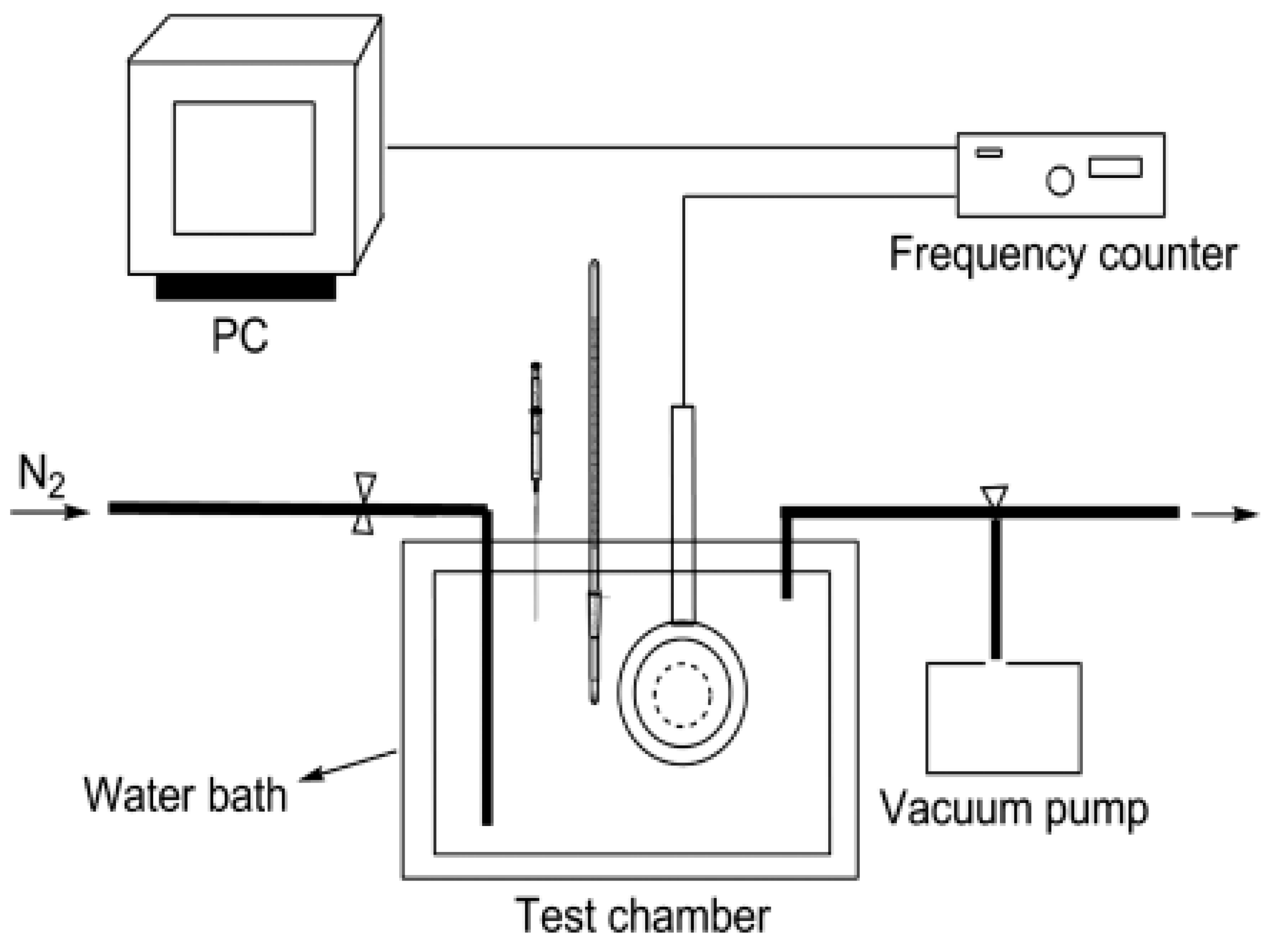
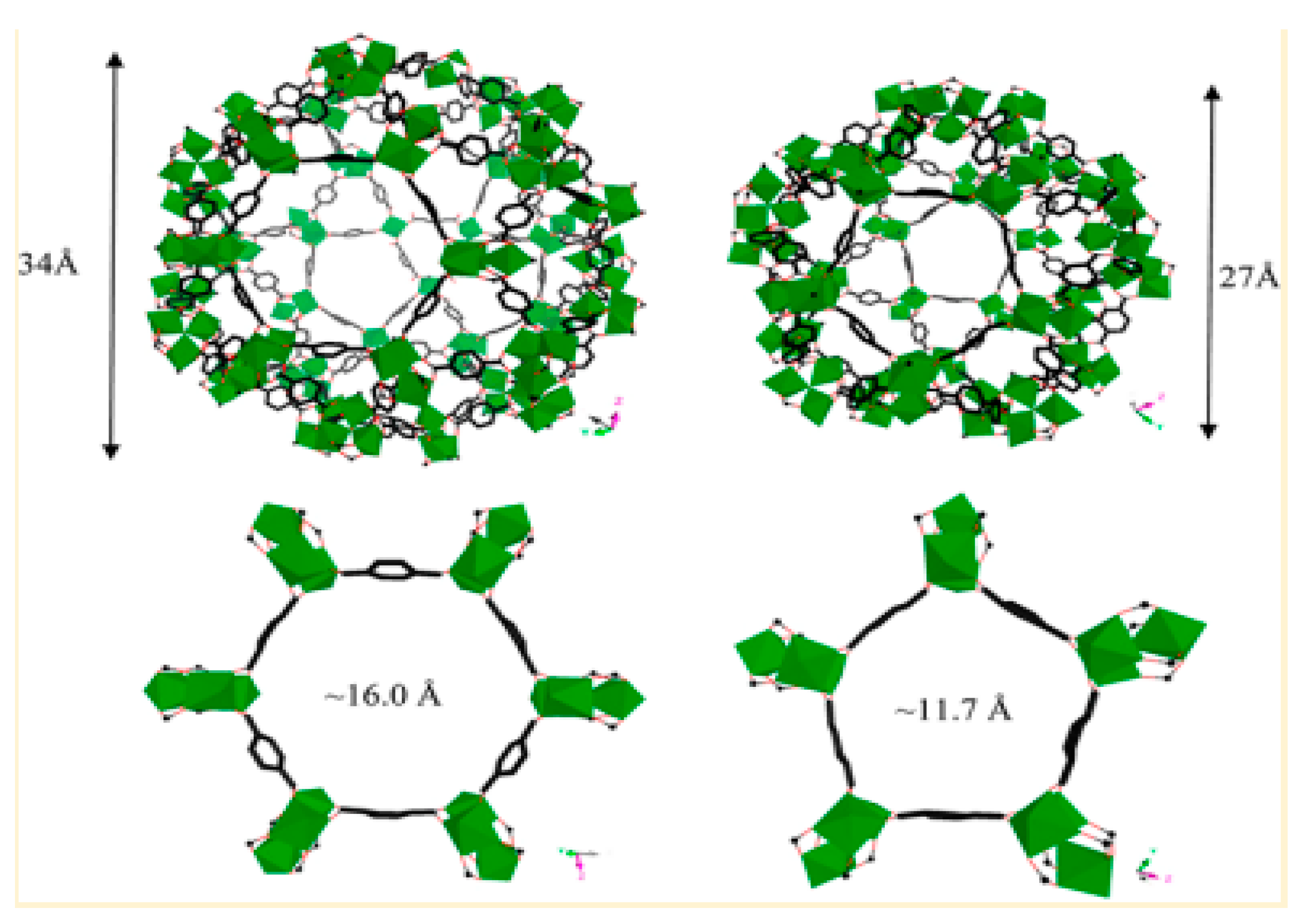
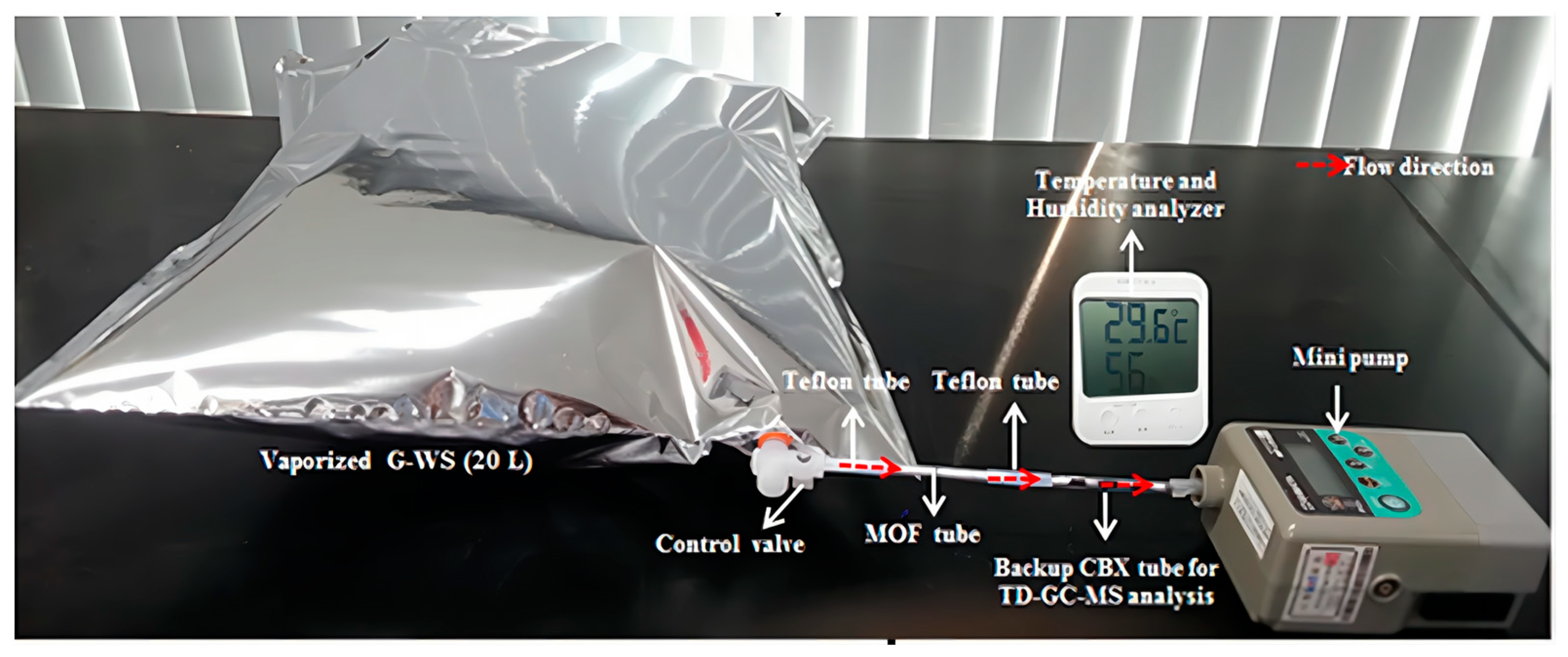
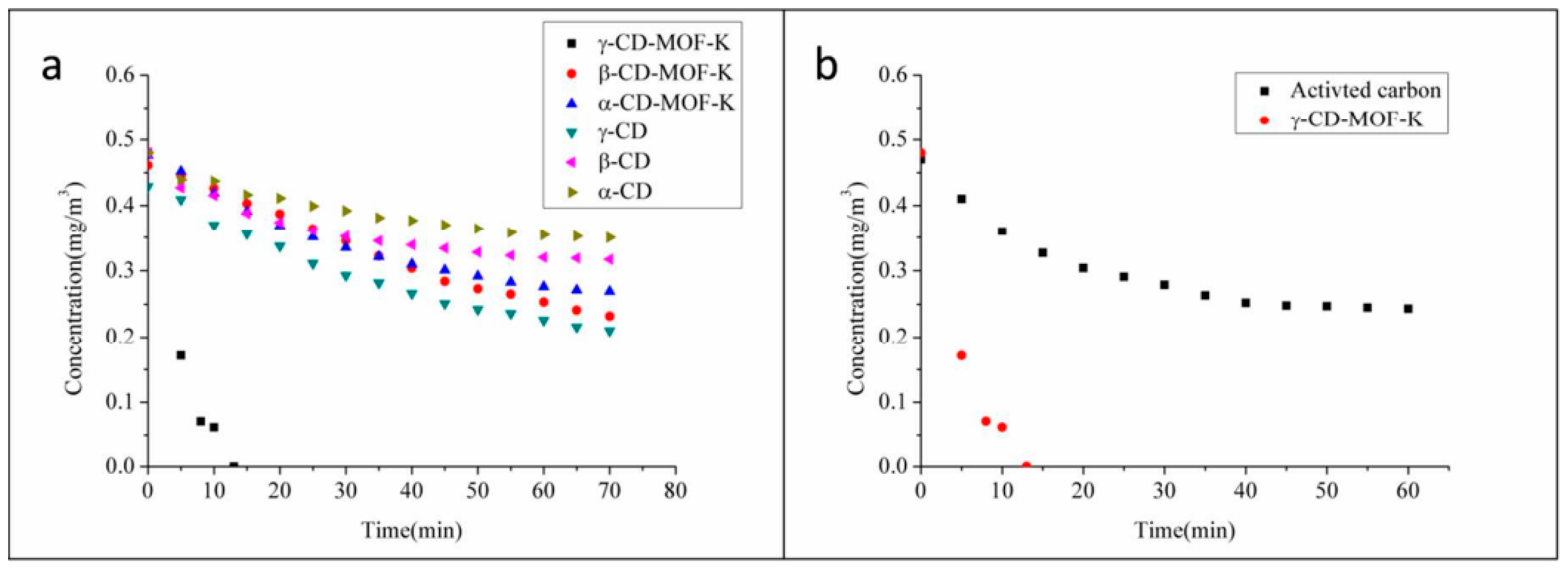

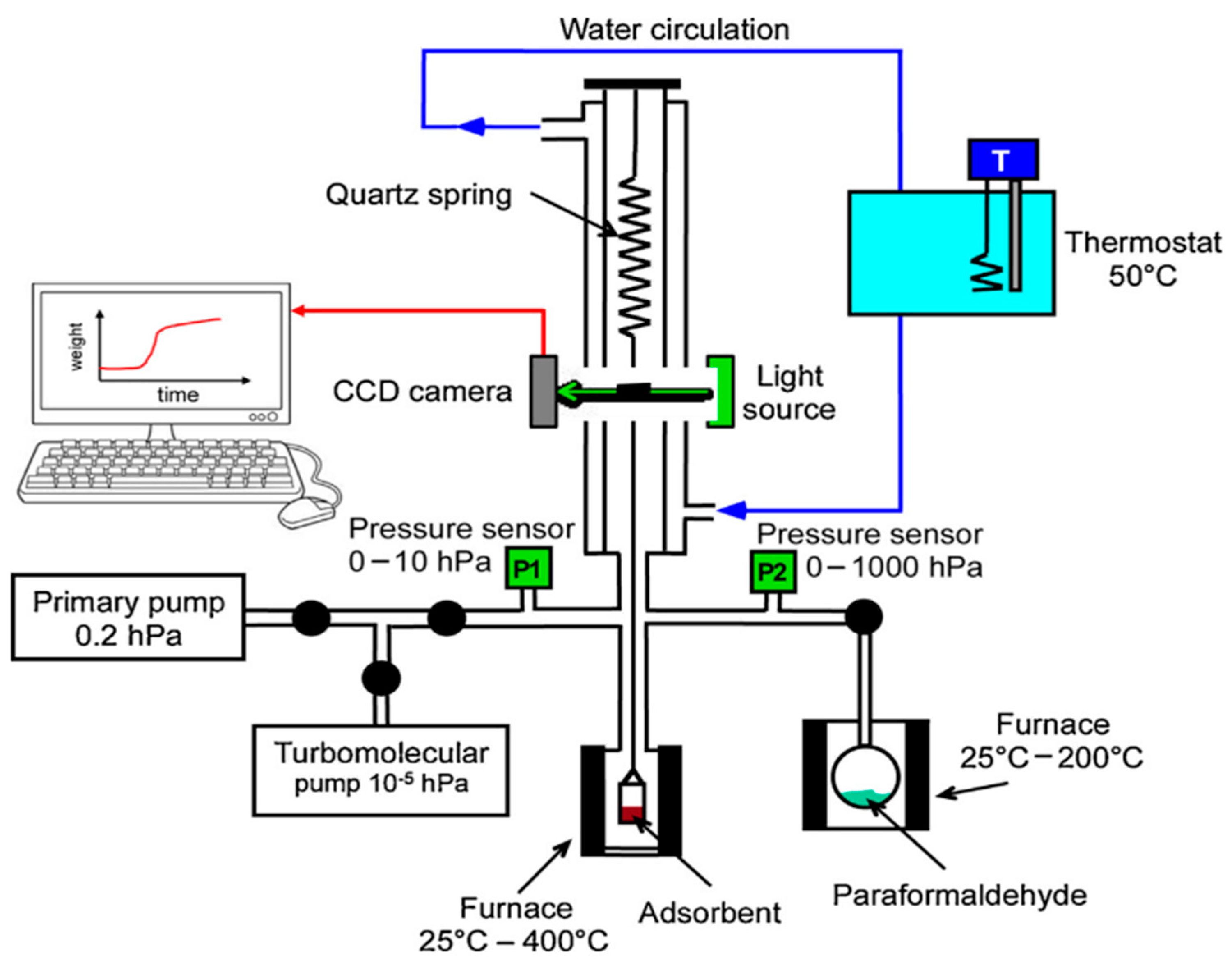
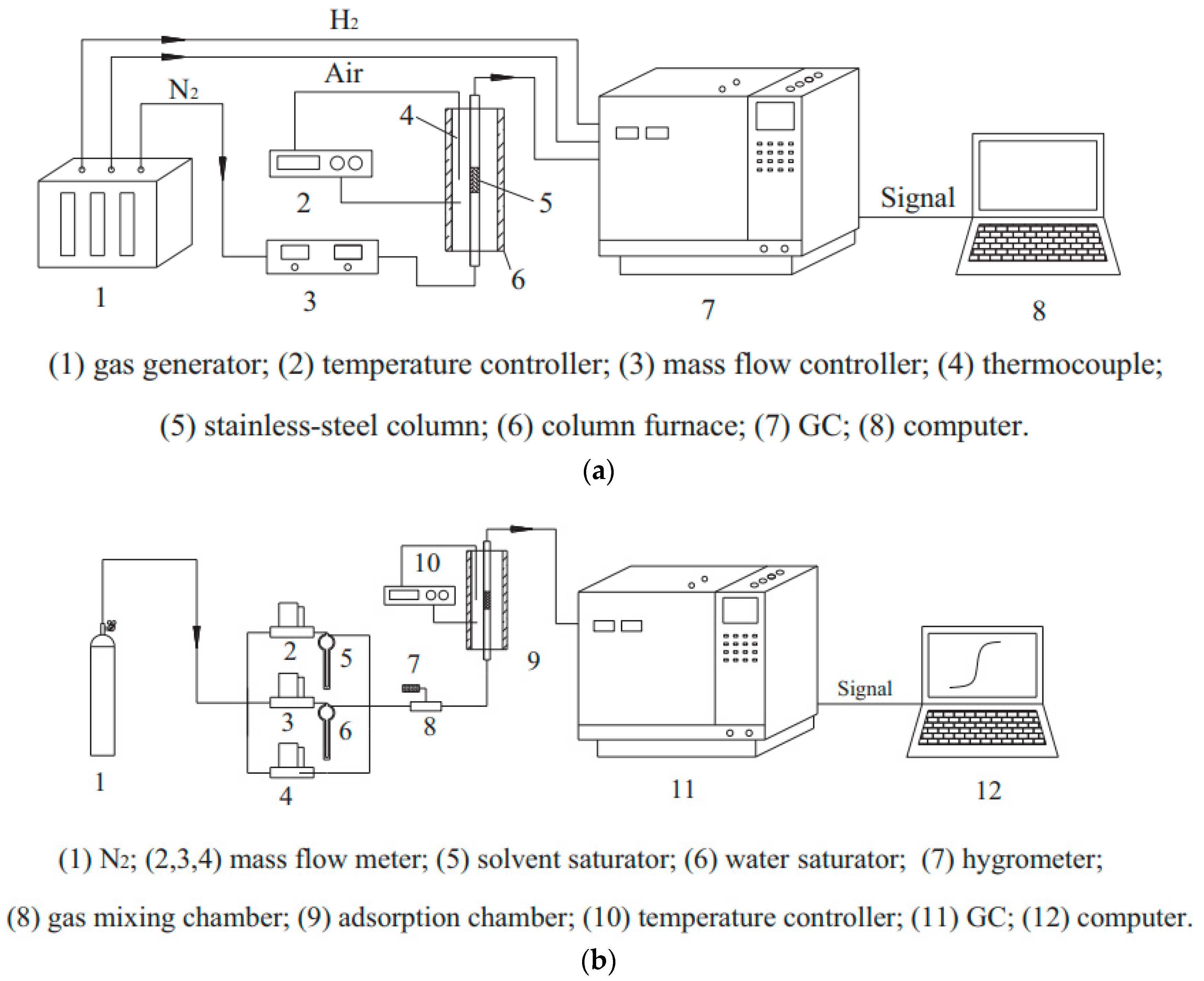
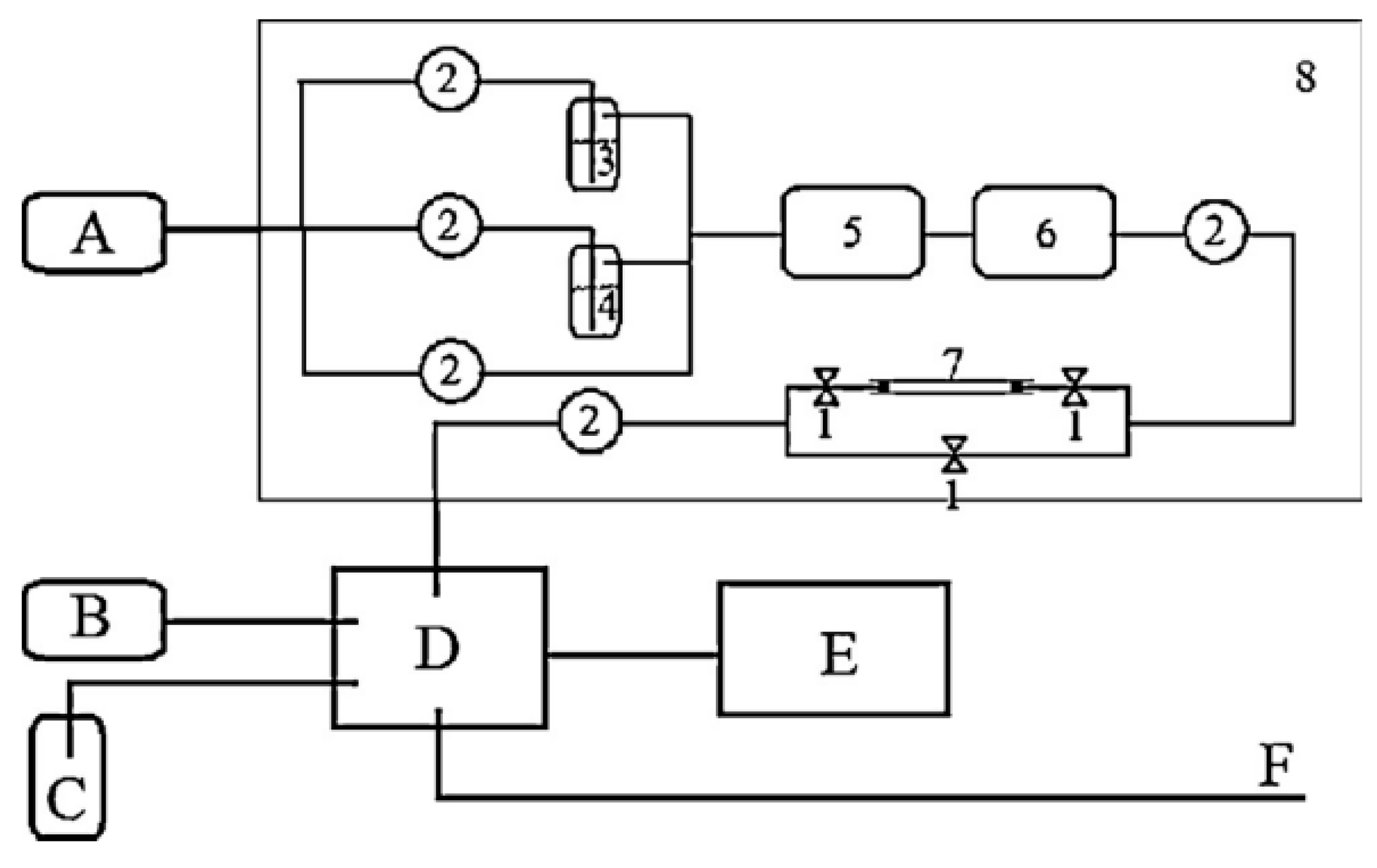
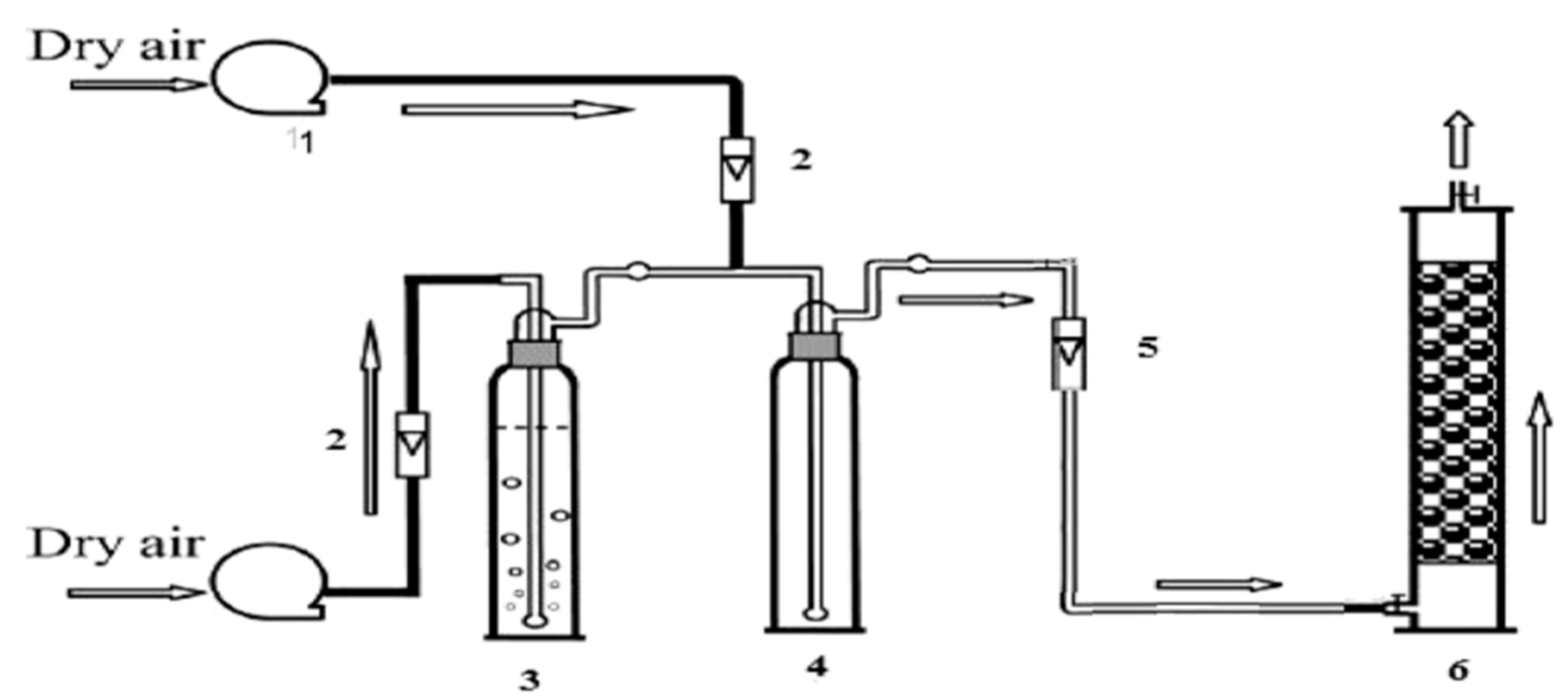
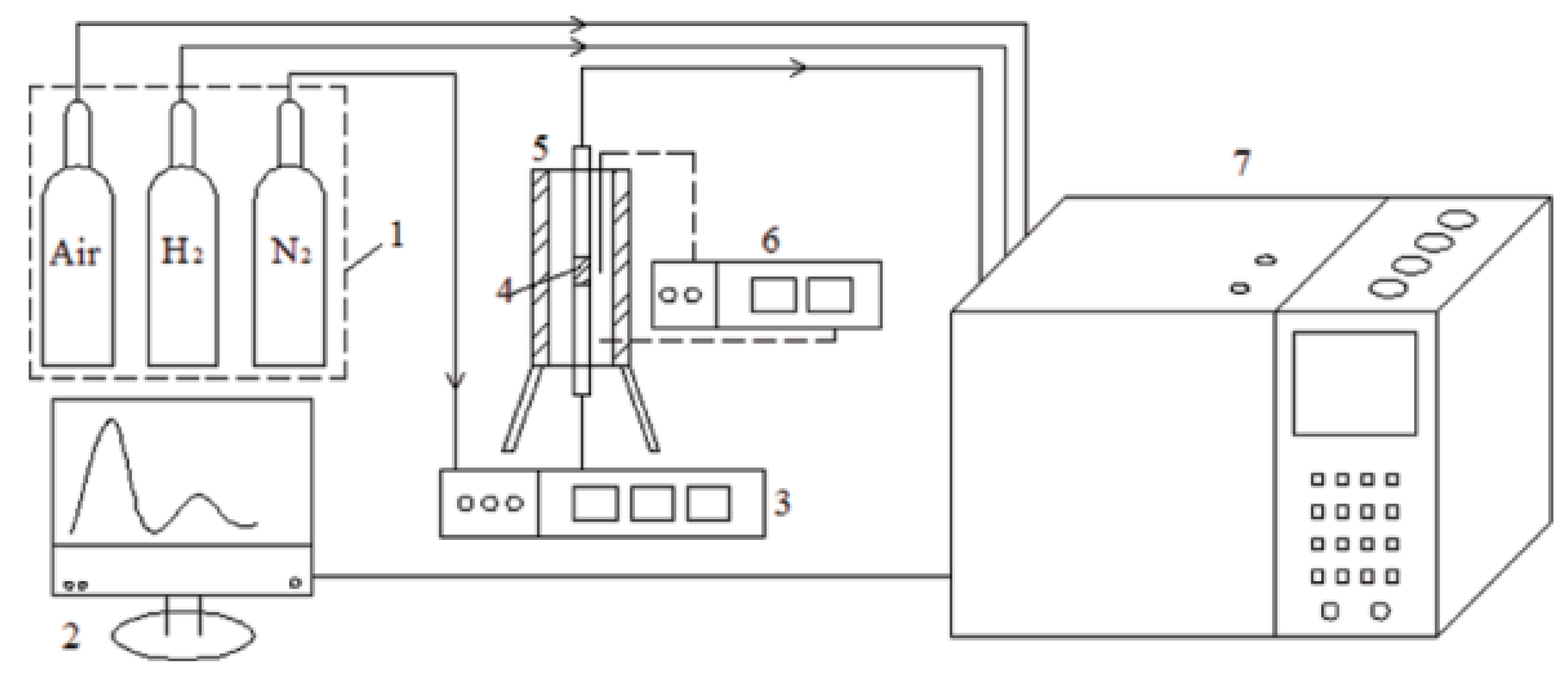
| Pollutants | Class I Civil Construction | Class II Civil Construction |
|---|---|---|
| Formaldehyde (Bq/m3) | ≤0.07 | ≤0.08 |
| Benzene (mg/m3) | ≤0.06 | ≤0.09 |
| Toluene (mg/m3) | ≤0.15 | ≤0.20 |
| Xylene (mg/m3) | ≤0.20 | ≤0.20 |
| TVOC (mg/m3) | ≤0.45 | ≤0.50 |
| VOCs Classification | VOCs | Examples of Household Products |
|---|---|---|
| alcohols | 3-octanol, 2-ethyl alcohol | aerosols, window cleaners, paints, paint thinners, cosmetics, and adhesives |
| aldehydes | acetaldehyde | plastics, paints, foam insulation, glues, deodorants, fuels, hair dryers, cell phones, televisions, radiators, incense, irons, chargers, and tobacco smoke |
| formaldehyde | pressed wood products (plywood wallboard, particle board, and fiberboard), treated wood, foam insulation, water-based coatings, combustion sources, tobacco smoke, upholstered furniture, furniture fillers, carpets, durable pressed draperies, other textiles, glues/adhesives, cosmetics, cleaners, markers, ballpoint and pen inks, and dyes | |
| aromatics | benzene | tobacco smoke, paints, degreasers, adhesives, adhesive removers, home heating oils, home ovens, incense, molding waxes, displays, and plastics |
| toluene | fuel oil, paints, paint thinners, lacquer, adhesives, coatings, nail polish, furniture polish, shoe polish, monitors, televisions, irons, decorative lamps, cell phones, rechargeable batteries, printed matter, incense, exotic wood products, beads, cleaners, detergents, and cigarettes | |
| xylene | fuel oil, paints, paint thinners, degreasers, lubricants, waterproofing, plastics, synthetic rubber, polyester clothing, pesticides, cleaners, monitors, computers, chargers, game consoles, ovens, decorative lamps, hair dryers, cell phones, televisions, rechargeable batteries, printing materials, incense, beads, Christmas sprays, and tobacco smoke |
| Material | SBET m2/g | SLangmuir m2/g | Pore Volume cm3/g | Reference |
|---|---|---|---|---|
| MOF-199 | 1237 | 1591 | 0.47 | [29] |
| MOF-5 | 424 | 535 | 0.22 | [29] |
| ZIF-67 | 1401 | 1211 | 1.22 | [29] |
| Ni-MOF-74 | 882 | - | 0.385 | [31] |
| Mg-MOF-74 | 1174 | - | 0.556 | [31] |
| CPO-27-Zn | 979 | - | 0.28 | [32] |
| CPO-27-Co | 1083 | - | 0.36 | [32] |
| CPO-27-Ni | 1113 | - | 0.39 | [32] |
| MIL-101(Cr) | 3367 | - | 2.35 | [33] |
| Cu-3@MIL-101(Cr) | 2518 | - | 1.55 | [33] |
| MIL-100(Fe) | 1398.7 | - | 1.085 | [34] |
| MIL-101(Fe) | 873.3 | - | 0.737 | [34] |
| MIL-53(Fe) | 268.6 | - | 0.338 | [34] |
| UiO-66-NH2 | 568 | 765 | 0.36 | [35] |
| C-U-N-0.5 | 795 | 978 | 0.39 | [35] |
| UiO-66(Zr) | 1300 | - | 1.65 | [36] |
| Ga-MIL-53 | 560 | - | - | [37] |
| MIL-101 | 2367 | - | 1.48 | [38] |
| MOF-199 | 1212 | - | 0.46 | [39] |
| UiO-66-NH2 | 963 | - | 0.58 | [39] |
| HKUST-1 | 1400 | - | 0.56 | [40] |
| Fe-HK-2 | 1707 | - | 0.93 | [40] |
| HKUST-1 | 1568.5 | 2081.4 | 0.75 | [41] |
| MOF-177 | 2970 | 4170 | 1.11 | [42] |
| MOF-47 | 755 | - | 0.28 | [43] |
| MIL-125-NH4 | 1450 | - | 0.61 | [43] |
| MIL-140B | 420 | - | 0.17 | [43] |
| Silica gels A | 756 | - | 0.45 | [44] |
| Silica gels B | 514 | - | 0.76 | [44] |
| Silica gels | 766 | - | 0.44 | [45] |
| Zeolite-HMOR | 270 | - | 0.087 | [46] |
| Zeolite-NMOR | 332 | - | 0.162 | [46] |
| Zeolite-MS13X | 582 | - | 0.215 | [46] |
| Zeolite-HY5.6 | 650 | - | 0.228 | [46] |
| Zeolite-HY4.8 | 663 | - | 0.284 | [46] |
| Zeolite-HY901 | 591 | - | 0.298 | [46] |
| DAY zeolite | 704 | - | 0.268 | [47] |
| AC | 1084 | - | 0.63 | [48] |
| AC | 786 | - | 0.33 | [49] |
| MOFs | VOCs | Adsorption Mechanism | Reference |
|---|---|---|---|
| MIL-101(Cr) | n-hexane, toluene, methanol, butanone, dichloromethane, n-butylamine | metal site adsorption | [67] |
| Cu-3@MIL-101 | benzene | metal site adsorption | [33] |
| Cu-MOF-199 | benzene, toluene, styrene, m-xylene, methyl ethyl ketone, methyl isobutyl ketone, butyl acetate, isobutanol | metal site adsorption | [68] |
| Cu3(BTC)2 | cyclohexane, benzene, and toluene | metal site adsorption | [69] |
| MIL-100(Fe) | toluene | π-bond adsorption | [34] |
| MIL-101(Cr) | hexane, benzene | π-bond adsorption | [70] |
| MOF-5, Eu-MOF, MOF-199 | benzene | π-bond adsorption | [71] |
| MIL-100(Fe) | toluene | π-bond adsorption | [72] |
| γ-CD-MOF-K | formaldehyde | hydrogen bonding adsorption | [74] |
| MIL-101/GO | CCL4 | hydrogen bonding adsorption | [78] |
| MOFs | VOCs | Adsorption Method | Capacity | Reference |
|---|---|---|---|---|
| MIL-100(Fe) | toluene | static adsorption of pure steam | 663 mg/g | [34] |
| MIL-101(Fe) | toluene | static adsorption of pure steam | 180 mg/g | [34] |
| MIL-53(Fe) | toluene | static adsorption of pure steam | 114 mg/g | [34] |
| UiO-66-NH2 | toluene | dynamic adsorption, penetration method (1000 ppm) | 162 mg/g | [35] |
| MC-500-6 | benzene | pure vapor | 12.8 mmol/g | [85] |
| MOF-199 | benzene | pure steam | 6.4 mmol/g | [39] |
| Fe-HK-2 | benzene | pure steam | 11.4 mmol/g | [40] |
| MG/MOF-1:2 | benzene | pure steam | 24.5 mmol/g | [86] |
| MOF-177 | acetone | pure steam | 589 mg/g | [42] |
| GrO@MIL-101 | acetone | pure steam | 20.1 mmol/g | [89] |
| MIL-101 | xylene | pure steam | 10.9 mmol/g | [91] |
| MIL-101(Cr) | ethylbenzene | 500ppm | 182 mg/g | [93] |
| MIL-53(Fe) | ethylbenzene | 550ppm | 52 mg/g | [93] |
| MIL-101(Cr) | dichloroethane | - | 19 mmol/g | [94] |
Disclaimer/Publisher’s Note: The statements, opinions and data contained in all publications are solely those of the individual author(s) and contributor(s) and not of MDPI and/or the editor(s). MDPI and/or the editor(s) disclaim responsibility for any injury to people or property resulting from any ideas, methods, instructions or products referred to in the content. |
© 2023 by the authors. Licensee MDPI, Basel, Switzerland. This article is an open access article distributed under the terms and conditions of the Creative Commons Attribution (CC BY) license (https://creativecommons.org/licenses/by/4.0/).
Share and Cite
Wang, K.; Nie, J.; Huang, H.; He, F. Literature Review on the Indoor Air VOCs Purification Performance of Metal–Organic Frameworks. Sustainability 2023, 15, 12923. https://doi.org/10.3390/su151712923
Wang K, Nie J, Huang H, He F. Literature Review on the Indoor Air VOCs Purification Performance of Metal–Organic Frameworks. Sustainability. 2023; 15(17):12923. https://doi.org/10.3390/su151712923
Chicago/Turabian StyleWang, Kaiqiao, Jinzhe Nie, Honghao Huang, and Fuqun He. 2023. "Literature Review on the Indoor Air VOCs Purification Performance of Metal–Organic Frameworks" Sustainability 15, no. 17: 12923. https://doi.org/10.3390/su151712923
APA StyleWang, K., Nie, J., Huang, H., & He, F. (2023). Literature Review on the Indoor Air VOCs Purification Performance of Metal–Organic Frameworks. Sustainability, 15(17), 12923. https://doi.org/10.3390/su151712923






